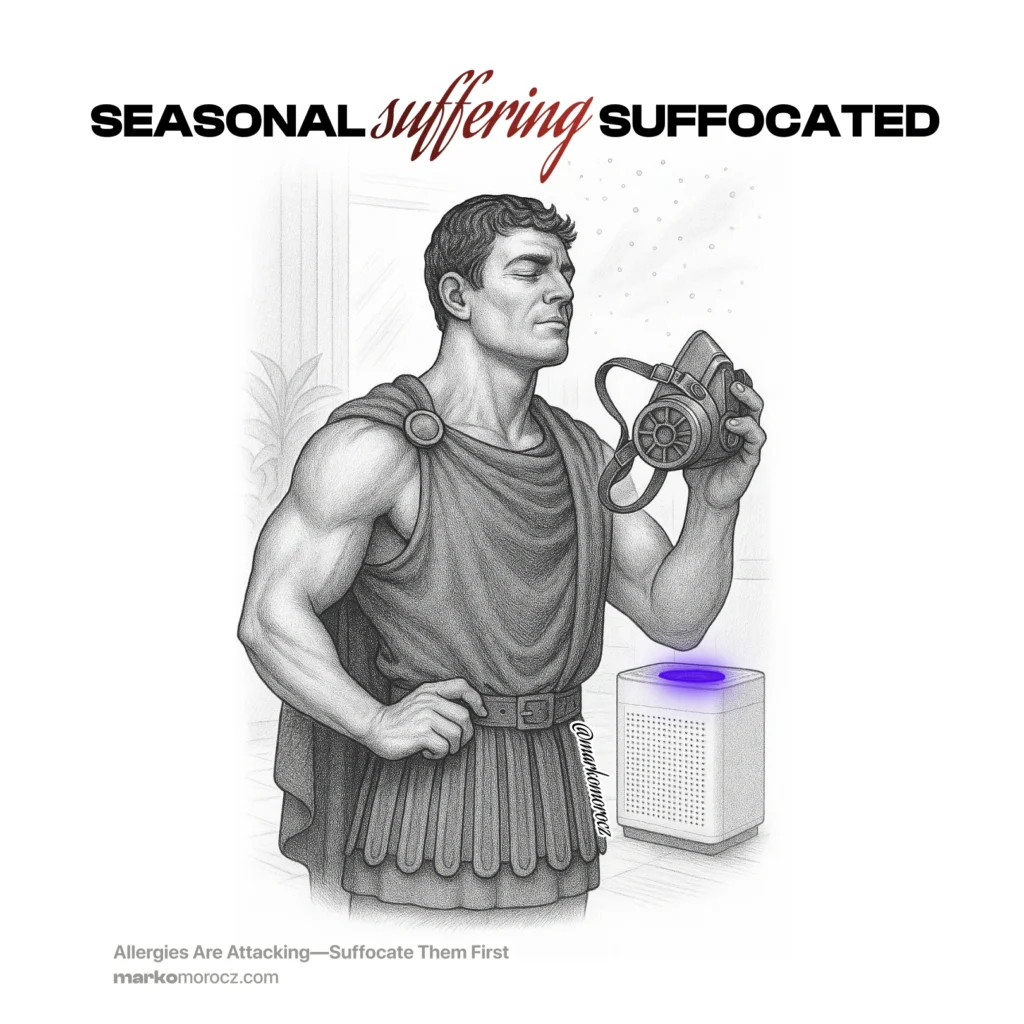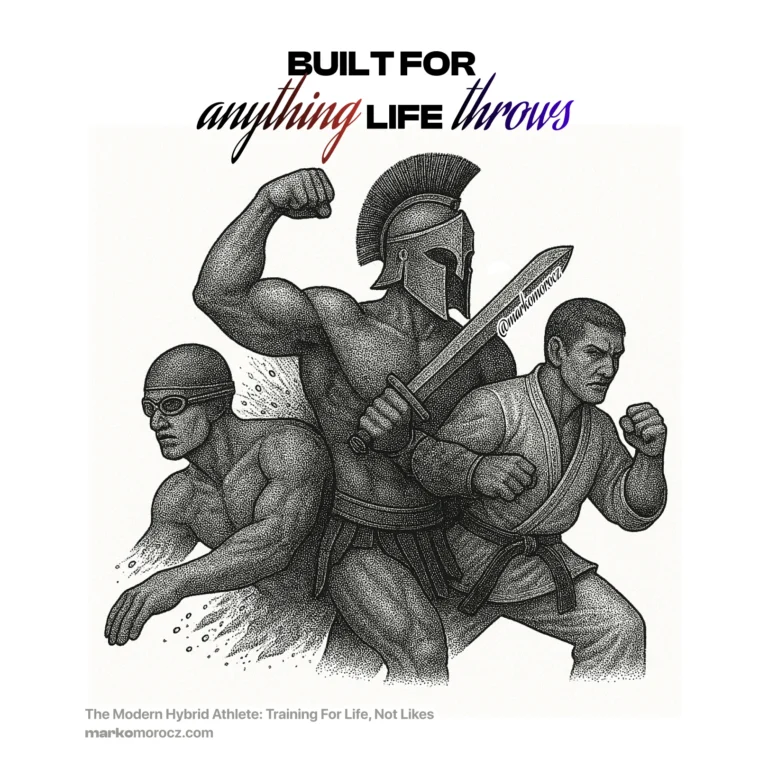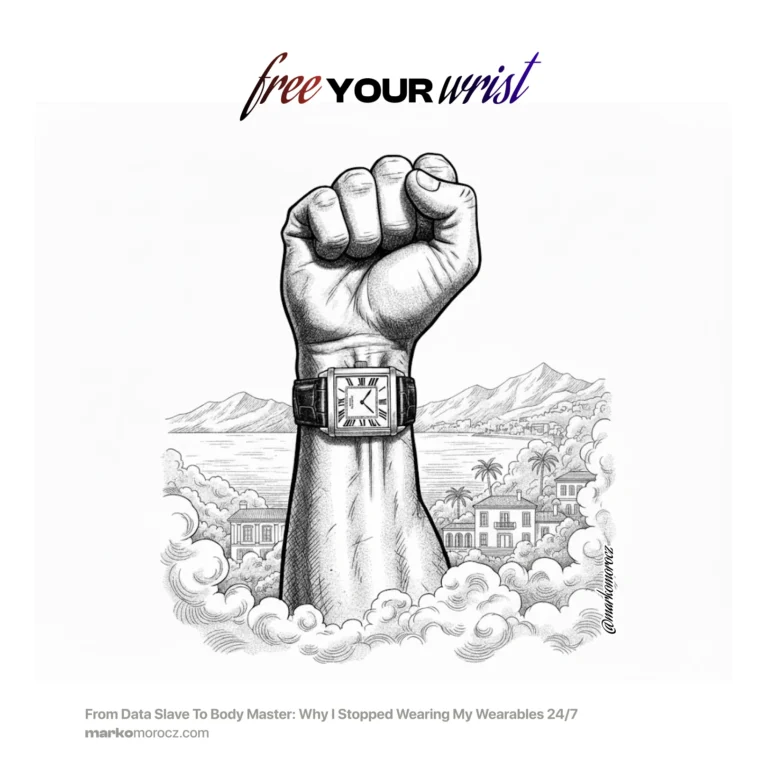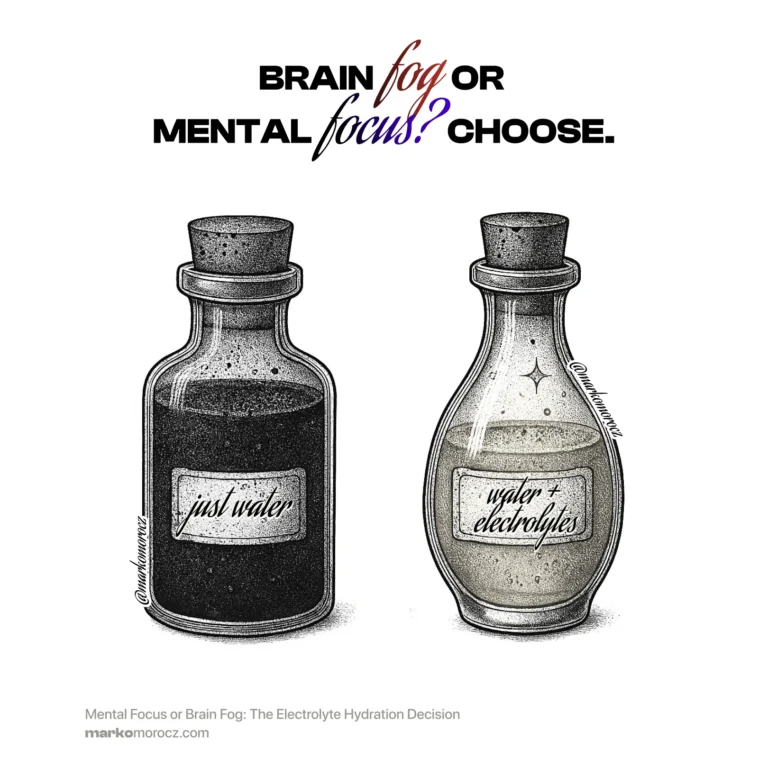Allergies Are Attacking—Suffocate Them First
Your eyes are watering. Your nose is running like a faucet. You’re sneezing every thirty seconds.
Welcome to allergy season. Where your immune system mistakes harmless pollen for invading armies and launches full-scale biological warfare against your own body.
But here’s the thing about allergies. They’re not random acts of nature. They’re predictable patterns with identifiable triggers and proven countermeasures.
Stop suffering. Start strategizing.

The Perfect Storm: When Weather Becomes Your Enemy
Heavy rain soaks everything. Plants get stressed. Then the sun comes out, temperatures spike, and winds pick up.
What happens next? Pollen apocalypse.
Rain-stressed plants panic and release 5-10x their normal pollen load.1 Heat concentrates allergens in the air. Wind turns your city into a giant pollen blender.
If you’ve ever noticed your allergies are worst after stormy weather followed by hot, windy days—this is why. You’re not imagining it. You’re experiencing nature’s perfect allergy storm.
The Indoor Fortress: Your Clean Air Sanctuary
Your home should be your refuge. Not another battlefield.2 But most people’s “clean” indoor air is actually dirtier than they think.
The Plant Mythology
Let’s kill this myth first. Houseplants won’t save you from allergies.
The famous NASA study? It used sealed chambers with fans blowing over plants for 24 hours.3 In real homes, you’d need 10-100 plants per room for meaningful air cleaning. Plus, plant soil can harbor mold, making allergies worse.
Plants are beautiful. They’re not medical devices.
The Air Purifier Reality Check
What actually works is a real HEPA filtration with activated carbon. Not “HEPA-type” or “99% efficient”. Actual True HEPA that captures 99.97% of particles 0.3 microns and larger.4
The Champions:
Xiaomi Smart Air Purifier 4 Lite (~€150-200):
- 360 m³/h CADR (serious cleaning power)
- Real-time PM2.5 monitoring
- Smart app control for remote operation
- Coverage up to 42m²
- Portable enough for room-to-room use
Philips Series 3000i:
- Excellent HEPA filtration
- Real-time air quality feedback
- Solid European warranty and service
- Slightly more expensive but reliable
IKEA Options (budget-friendly):
- FÖRNUFTIG (~€40): Basic but functional
- STARKVIND (~€150): Better performance, furniture-like design
- Lower CADR ratings but decent for smaller spaces
The 48-Hour Purge Protocol: Maximum Allergen Elimination
Getting an air purifier isn’t enough. You need to deploy it strategically for maximum allergen annihilation.
The Initial Attack (First 48 Hours)
Run on MAX speed continuously for 24-48 hours. Close ALL windows and doors. Your purifier can only clean what’s sealed inside.
Clean all surfaces while purifier runs. Settled pollen on furniture defeats the purpose. Shower and change clothes after any outdoor exposure.
Why 48 hours matters
Your Xiaomi 4 Lite has a 360 m³/h CADR rating. For a 30m² room with 2.5m ceilings (75m³ total volume), it processes the entire room’s air 4.8 times per hour on max speed. But pollen isn’t just floating. It’s settled on surfaces, hiding in fabrics, clinging to everything.
Critical insight: The sensor can’t see your enemy.
Here’s what air purifier companies don’t tell you: PM2.5 sensors can’t detect most pollen.
Pollen grains are 10-100 microns in size, while PM2.5 sensors only detect particles 2.5 microns and smaller. Your app might show “Excellent” air quality during a pollen storm because the sensor is blind to the actual threat.
But your HEPA filter captures pollen regardless of what the sensor shows. Don’t trust the app reading during allergy season. Trust your respiratory system’s feedback instead.
How to know it’s actually working?
Less sneezing and clearer breathing within 24-48 hours. Better sleep quality when bedroom air is continuously filtered. Less dust settling on surfaces. Compare how you feel waking up versus going to sleep.
Most people notice significant relief within 24-48 hours of proper implementation, with full benefits developing over 1-2 weeks.
The Carry Strategy: Portable Clean Air
Here’s what most people miss: air purifiers are portable weapons.
Move yours strategically:
- Day: Living room/office (where you spend most time)
- Evening: Bedroom (for clean sleep air)
- Travel: Pack it for hotels and different cities
A 6.5kg air purifier travels better than you think. Throw it in your car for road trips. Different cities have different allergen profiles. Your portable clean air bubble goes everywhere.
The Essential Upgrade: Filter Replacement Strategy
Buy an extra filter with your purifier.
During heavy allergy seasons, filters clog faster. Having a spare means:
- Instant swap when performance drops
- No waiting 1-2 weeks for delivery during peak pollen
- Locked-in pricing (filter costs increase over time)
- 1-2 years of clean air security
Filter lifespan reality:
- Normal use: 6-12 months
- Heavy allergy season: 3-6 months
- Post-storm pollen bombs: Even faster
AC vs. Air Purifier: Understanding Your Air Sources
The AC confusion is big. Most people assume AC units bring in fresh outside air. And pollen. This isn’t always true.
- Split AC units (most common): Recirculate indoor air only – no outside air intake. They help allergy control when windows stay closed and filter some particles through basic AC filters.
- Central AC systems: May have fresh air intake – check your settings. Turn off ventilation mode during high pollen periods. Upgrade to MERV 11-13 filters for better pollen capture.
- Window AC units: Check the vent setting – close any “fresh air” intake. Use recirculation mode only during allergy season.
Your strategy: Seal your space (windows closed, AC on recirculate). Air purifier does the heavy lifting (active HEPA filtration). AC maintains temperature without adding pollen load.
Your AC creates the sealed environment. Your air purifier creates the clean environment.
Mobile Defense: Tactical Respiratory Protection
When you venture into the allergen war zone, you need tactical gear.
The Mask Reality Check
Useless for allergies:
- Surgical masks (gaps too large for pollen)
- Basic cloth masks
- Fashion masks with no filtration rating
Effective options:
Hardware Store Solution: FFP2/N95 masks from construction supply stores:
- 3M Aura 9320+ (comfortable, good seal)
- 3M 8822 (classic, reliable)
- Look for CE marking and FFP2 certification
- Cost: ~€0.20-0.50 per mask
Premium Performance: Respro Cinqro Urban Sports Mask:
- HEPA-Type filter blocks 99.97% of particles
- Dynamic Activated Carbon Cloth (DACC) for chemical pollutants
- Neoprene construction for comfort during activity
- Washable and reusable with replaceable filters
- Designed for cycling, running, and active outdoor use
When to Deploy Your Mask
Peak pollen times:
- 10am-3pm during hot days
- Windy conditions (pollen gets stirred up)
- Post-rain periods (massive pollen release)
- Any outdoor walking/cycling during allergy season
Strategic usage:
- Home → Car: Mask on
- In car: Mask off, AC recirculation mode
- Car → Destination: Mask back on
- Indoors: Mask off, air purifier running
Vehicle Tactics: Your Mobile Clean Zone
Optimal car settings during allergy season:
- Windows UP always during pollen season
- AC recirculation ON (circular arrow button)
- Fresh air intake OFF during high pollen times
- Cabin air filter already blocks most pollen when properly maintained
Your car’s AC system with recirculation creates a sealed environment. No need for masks while driving. Just ensure you’re not pulling outside air into the cabin.
The Science of Seasonal Suffering
Why allergies hit harder some years:
- Climate change extends pollen seasons by 2-3 weeks5
- Higher CO2 levels make plants produce more pollen6
- Urban heat islands concentrate allergens
- Weather pattern changes create more intense pollen events
Pollen timing patterns:
- Tree pollen: Early spring (March-May)
- Grass pollen: Late spring/early summer (May-July)
- Weed pollen: Late summer/fall (August-October)
- Mold spores: After rain, in humid conditions
Advanced Defensive Protocols
The Post-Exposure Decontamination
After outdoor exposure during high pollen periods:
- Shower immediately – removes pollen from hair and skin
- Change clothes – pollen clings to fabric
- Wash face and hands – removes facial allergen contact
- Rinse nasal passages – saline rinse clears direct exposure
The Preemptive Strike
Start defense before symptoms hit:
- Monitor local pollen forecasts
- Begin air purifier use early in season
- Prep masks and indoor protocols
- Maintain indoor humidity between 30-50% during allergy season. Too low makes pollen more airborne; too high encourages mold growth that worsens symptoms
- Consider antihistamine timing (consult healthcare provider)
The Sleep Sanctuary Protocol
Bedroom optimization:
- Air purifier running continuously during allergy season
- Keep windows closed during peak pollen times
- Wash bedding in hot water weekly
- Consider HEPA vacuum for carpet/upholstery
- Shower before bed to remove daily pollen accumulation
Strategic Pharmaceutical Support: When Tactical Gear Needs Backup
Sometimes your environmental defenses aren’t enough. When allergic responses are severe enough to compromise your immune system – leaving you vulnerable to infections, viruses, and other illnesses – strategic pharmaceutical intervention becomes necessary.
The immune system reality
Chronic allergic inflammation doesn’t just make you miserable. It diverts your immune resources away from fighting actual threats like bacteria and viruses. Your body wastes energy battling harmless pollen instead of protecting against real pathogens.
Second-generation antihistamines (like cetirizine, loratadine, fexofenadine) can provide the relief needed to:
- Restore normal immune function
- Maintain productivity during peak allergy seasons
- Allow your tactical defenses (air purifiers, masks) to work more effectively
- Prevent the cascade of sleep disruption → weakened immunity → increased illness susceptibility
The strategic approach
Think of antihistamines as temporary tactical support, not permanent solutions. Use them to:
- Bridge the gap while implementing environmental controls
- Handle unexpected high-pollen events (post-storm pollen bombs)
- Maintain functionality during peak seasonal periods
- Support your immune system’s ability to fight actual threats
Timing matters: Many antihistamines work better as preventive measures than reactive treatments. Consider starting them before peak allergy season begins, not after symptoms hit.
Always consult healthcare providers for proper medication selection, timing, and dosing protocols.
The Long-Term Strategy: Building Allergy Resilience
Environmental modifications:
- HEPA filtration throughout living spaces
- High-quality cabin air filters in vehicles
- Air quality monitoring to track patterns
- Strategic landscaping (if you control outdoor space)
Health optimization:
- Gut health support (70% of immune system is in digestive tract)
- Anti-inflammatory nutrition (omega-3s, quercetin, vitamin D)
- Stress management (chronic stress worsens allergic responses)
- Quality sleep (poor sleep amplifies inflammatory responses)
The Bottom Line: From Victim to Victor
Allergies aren’t a life sentence. They’re an environmental challenge with technological and tactical solutions.
Your defense arsenal:
- Home base: High-performance air purifier with spare filters
- Mobile protection: Quality respiratory mask for outdoor exposure
- Vehicle tactics: Sealed cabin with recirculation AC
- Strategic timing: Avoid peak pollen periods when possible
- Decontamination protocols: Post-exposure cleaning routines
The key insight: Allergies are predictable. Weather patterns trigger them. Technology can filter them. Tactics can avoid them.
Stop accepting seasonal suffering as inevitable. Start treating allergy management like the strategic challenge it is.
Your respiratory system is your life support. Defend it accordingly.
Choose technology over misery. Choose strategy over suffering. Choose breathing freely over seasonal surrender.
Your future self—the one who can actually enjoy spring and summer—will love you.
Got insights about your own allergy defense strategies? Drop them below—let’s build the ultimate respiratory protection protocol together.
References
- Subiza, J., et al. (1995). “Allergenic pollen and pollinosis in Madrid.” Journal of Allergy and Clinical Immunology, 96(1), 15-23. ↩︎
- Nazaroff, W. W. (2013). “Four principles for achieving good indoor air quality.” Indoor Air, 23(5), 353-356. ↩︎
- Wolverton, B. C., et al. (1989). “A study of interior landscape plants for indoor air pollution abatement.” NASA Technical Report. NASA-TM-108061. ↩︎
- Farmer, S. A., et al. (2021). “Efficacy of air purifiers for removal of airborne allergens in homes.” Journal of Allergy and Clinical Immunology, 147(2), AB194. ↩︎
- Ziska, L., et al. (2019). “Temperature-related changes in airborne allergenic pollen abundance and seasonality across the northern hemisphere: a retrospective data analysis.” The Lancet Planetary Health, 3(3), e124-e131. ↩︎
- Zhang, Y., et al. (2014). “Effect of ambient fine particulate matter on emergency room visits for childhood asthma in El Paso, Texas.” Environmental Health, 13(1), 42. ↩︎





